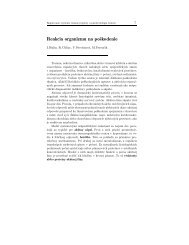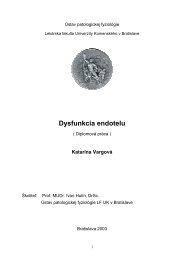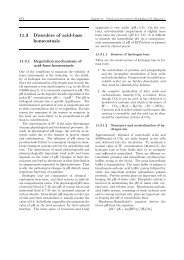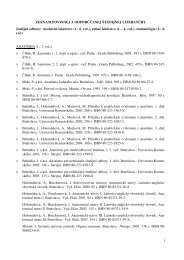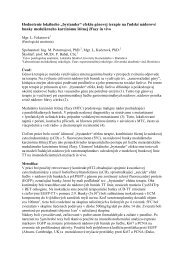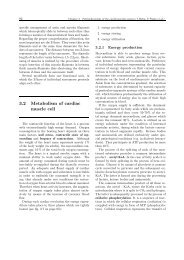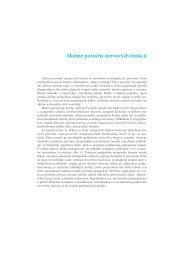5.7 Endocrine disorders of the ovaries
5.7 Endocrine disorders of the ovaries
5.7 Endocrine disorders of the ovaries
Create successful ePaper yourself
Turn your PDF publications into a flip-book with our unique Google optimized e-Paper software.
<strong>5.7</strong>. <strong>Endocrine</strong> <strong>disorders</strong> <strong>of</strong> <strong>the</strong> <strong>ovaries</strong> 391<br />
tolerance and hyperglycemia may occur during <strong>the</strong><br />
paroxysms, later after fasting are also present.<br />
In untreated patients with sustained arterial hypertension<br />
orthostatic hypotension is <strong>of</strong>ten present.<br />
It is manifested by a significant postural fall in blood<br />
pressure (more than 30 mmHg in comparison with<br />
current values <strong>of</strong> <strong>the</strong> patient) accompanied by dizzinesses.<br />
In some patients with orthostatic hypotension<br />
collapse may sometimes originate. Hypotension<br />
may last several minutes. During trauma or surgical<br />
intervention in untreated patients with pheochromocytoma<br />
unexplained hypotension or circulatory<br />
shock may develop.<br />
In <strong>the</strong> patients with untreated pheochromocytoma<br />
several factors probably participate in <strong>the</strong> origin <strong>of</strong><br />
orthostatic hypotension. It may be partly a consequence<br />
<strong>of</strong> hypovolemia (as a result <strong>of</strong> increased<br />
diuresis which is secondary to arterial hypertension<br />
and glycosuria), and partly a consequence <strong>of</strong><br />
blunted postural reflexes due to a prolonged excess<br />
<strong>of</strong> catecholamines. According to some authors orthostatic<br />
hypotension occurs mainly in <strong>the</strong> patients with<br />
oversecretion <strong>of</strong> adrenaline and enkephalins from<br />
pheochromocytoma.<br />
<strong>5.7</strong> <strong>Endocrine</strong> <strong>disorders</strong> <strong>of</strong> <strong>the</strong><br />
<strong>ovaries</strong><br />
<strong>Endocrine</strong> <strong>disorders</strong> <strong>of</strong> <strong>the</strong> <strong>ovaries</strong> are <strong>the</strong> third<br />
most common endocrinopathy, more frequent are<br />
only <strong>the</strong> thyroid gland <strong>disorders</strong> and <strong>the</strong> <strong>disorders</strong><br />
<strong>of</strong> <strong>the</strong> endocrine portion <strong>of</strong> <strong>the</strong> pancreas. Their classification<br />
has not been yet sufficiently transparent<br />
and uniform. At present pathogenetic classification<br />
has been considered most convenient. It is based on<br />
<strong>the</strong> following four criteria:<br />
1. The type <strong>of</strong> intensity <strong>of</strong> hormonal secretion, i.e.,<br />
hyposecretion or hypersecretion <strong>of</strong> ovarian hormones,<br />
respectively secretion <strong>of</strong> hormones atypical<br />
for <strong>ovaries</strong>.<br />
2. The place <strong>of</strong> origin <strong>of</strong> an endocrine disorder, i.e.,<br />
primary, secondary, or tertiary disorder <strong>of</strong> hormonal<br />
secretion.<br />
3. The basic cause <strong>of</strong> endocrine disorder, i.e., inborn<br />
or acquired endocrine disorder.<br />
4. Number <strong>of</strong> hormones <strong>of</strong> which secretion is impaired,<br />
i.e., disorder <strong>of</strong> only some or all ovarian<br />
steroid hormones.<br />
<strong>5.7</strong>.1 Ovarian endocrine hyp<strong>of</strong>unction<br />
Hyposecretion <strong>of</strong> ovarian hormones is denoted as<br />
female hypogonadism (hypogonadismus femininus).<br />
Its etiopathogenesis is ra<strong>the</strong>r variable. The cause<br />
<strong>of</strong> ovarian hormone deficiency may be within <strong>the</strong><br />
<strong>ovaries</strong> <strong>the</strong>mselves (primary female hypogonadism),<br />
in <strong>the</strong> adenohypophysis (secondary female hypogonadism),<br />
or in <strong>the</strong> hypothalamus (tertiary female hypogonadism).<br />
The clinical picture <strong>of</strong> ovarian hyp<strong>of</strong>unction<br />
depends on <strong>the</strong> age <strong>of</strong> a patient in <strong>the</strong> time<br />
<strong>of</strong> its origin. If <strong>the</strong> ovarian endocrine hyp<strong>of</strong>unction<br />
originates prior to puberty in girls its consequences<br />
begin usually to appear at <strong>the</strong> time <strong>of</strong> expected onset<br />
<strong>of</strong> puberty. Insufficient sexual maturation (sexual<br />
infantilism) develops. If <strong>the</strong> ovarian endocrine hyp<strong>of</strong>unction<br />
originates in adult female it is manifested<br />
by menstrual abnormalities and infertility.<br />
<strong>5.7</strong>.1.1 Primary ovarian hyp<strong>of</strong>unction<br />
Primary (peripheral) ovarian hyp<strong>of</strong>unction is acomplete<br />
disorder <strong>of</strong> ovarian hormone secretion, i.e., <strong>the</strong><br />
production <strong>of</strong> all ovarian steroid hormones is insufficient.<br />
Primary ovarian hyp<strong>of</strong>unction can result from<br />
multiple causes, but principally it may be inborn or<br />
acquired. The menopause is a special form <strong>of</strong> primary<br />
ovarian hyp<strong>of</strong>unction (physiological cessation<br />
<strong>of</strong> ovarian function). However, cessation <strong>of</strong> ovarianfunctioncanoccuratanyage,eveninutero.<br />
If<br />
it occurs before puberty, <strong>the</strong> presentation is as primary<br />
amenorrhea; after pubertal development and<br />
menarche <strong>the</strong> presentation is as secondary amenorrhea.<br />
Due to decreased plasma ovarian hormone concentrations<br />
hypothalamic-adenohypophyseal area is<br />
stimulated to increased secretion <strong>of</strong> gonadotropins<br />
by feedback mechanism. The pituitary gonadotropin<br />
concentrations in circulating blood are, <strong>the</strong>refore, increased<br />
(hypergonadotropic female hypogonadism).
392 Chapter 5. Pathophysiology <strong>of</strong> endocrine system ( L. Zlatoš)<br />
A. Inborn primary ovarian hyp<strong>of</strong>unction<br />
It may originate due to ovarian agenesis, gonadal<br />
dysgenesis with abnormal karyotype (most common<br />
Turner syndrome), gonadal dysgenesis with normal<br />
karyotype (pure gonadal dysgenesis), or ovarian 17αhydroxylase<br />
deficiency (adrenal cortex is usually simultaneously<br />
affected by this hereditary enzymopathy<br />
as well). Inborn primary ovarian hyp<strong>of</strong>unction<br />
occurs in about 30 % <strong>of</strong> female patients with a disorder<br />
<strong>of</strong> sexual maturation.<br />
Turner syndrome<br />
It is <strong>the</strong> best known form <strong>of</strong> inborn primary ovarian<br />
hyp<strong>of</strong>unction and most common among gonosomal<br />
anomalies causing <strong>the</strong> disorder <strong>of</strong> sexual maturation<br />
<strong>of</strong> adolescent girls. Its incidence in female<br />
population is about 0.03 %.<br />
From <strong>the</strong> cytogenetic point <strong>of</strong> view it is asimple<br />
monosomy X manifested by <strong>the</strong> 45,X karyotype <strong>of</strong><br />
all cells <strong>of</strong> <strong>the</strong> patient (symbolic sign is 45,X0). Mosaic<br />
monosomy X is also known. In <strong>the</strong> patients with<br />
mosaicism <strong>the</strong> cells with <strong>the</strong> normal 46,XX karyotype<br />
occur along with <strong>the</strong> cells with <strong>the</strong> 45,X0 karyotype<br />
(<strong>the</strong> 45,X0/46,XX karyotype). O<strong>the</strong>r mosaic patterns,<br />
e.g., 45,X0/47,XXX or 45,X0/46,XX/47,XXX,<br />
are rarer. Genotype and phenotype <strong>of</strong> <strong>the</strong> affected<br />
individual is female. Due to gonosomal anomaly only<br />
bilateral streak rudimentary gonads (dysgenetic gonads)<br />
are present instead <strong>of</strong> <strong>the</strong> <strong>ovaries</strong>. Nei<strong>the</strong>r oogenesis<br />
nor biosyn<strong>the</strong>sis <strong>of</strong> steroid hormones are realized<br />
in <strong>the</strong>se fibrous gonadal streaks. Therefore, it<br />
is characterized primarily by hypogonadism in phenotypic<br />
female.<br />
The clinical picture <strong>of</strong> simple monosomy X (typical<br />
Turner syndrome, <strong>the</strong> classic form <strong>of</strong> <strong>the</strong> 45,X0<br />
gonadal dysgenesis) is characterized by short stature,<br />
multiple congenital anomalies, and disorder <strong>of</strong> sexual<br />
maturation.<br />
In adult affected women, <strong>the</strong> average height rarely<br />
exceeds 150 cm, <strong>the</strong> legs are usually shorter compared<br />
with <strong>the</strong> trunk (disproportional stature). The<br />
growth retardation and disorder <strong>of</strong> skeletal maturation<br />
appear in about 8th year <strong>of</strong> age. They are supposed<br />
to be <strong>the</strong> secondary changes conditioned by<br />
deficiency <strong>of</strong> estrogens, probably secondary to <strong>the</strong><br />
lack <strong>of</strong> <strong>the</strong> estrogen-induced rise in plasma growth<br />
hormone concentration and consequently insufficient<br />
production <strong>of</strong> IGF I at puberty. As yet, <strong>the</strong> exact<br />
cause <strong>of</strong> <strong>the</strong> progressive growth failure has not been<br />
defined. It is also considered that <strong>the</strong> abnormality<br />
resides in <strong>the</strong> response <strong>of</strong> <strong>the</strong> chondrocyte to <strong>the</strong> somatomedins.<br />
The most common congenital somatic anomalies<br />
<strong>of</strong> Turner syndrome include: short and broad neck<br />
(even bilateral neck webbing) with a low posterior<br />
hairline; redundant skin folds on <strong>the</strong> back <strong>of</strong> <strong>the</strong><br />
neck (pterygium colli); micrognathia (shortened upper<br />
jaw); prominent, low-set, rotated or deformed<br />
ears or both; a fish-like mouth; a narrow, high arched<br />
palate (Gothic palate); ptosis; a square shield-like<br />
chest with widely spaced nipples; and increased number<br />
<strong>of</strong> pigmented nevi. Additional anomalies which<br />
are less common include: cubitus valgus, short fourth<br />
metacarpals, strabismus, congenital heart disease<br />
and renal abnormalities, lymphedema <strong>of</strong> <strong>the</strong> dorsum<br />
<strong>of</strong> <strong>the</strong> hands and feet, puffiness <strong>of</strong> <strong>the</strong> dorsum <strong>of</strong> <strong>the</strong><br />
fingers, and hypoplastic nails. Sometimes also fur<strong>the</strong>r<br />
skeletal anomalies may be present.<br />
The genital ducts and external genitalia are female<br />
in character (female phenotype) but immature.<br />
The external and internal genitalia remain infantile,<br />
<strong>the</strong>re is no breast development, uterus and tubes are<br />
hypoplastic, and menstruation is absent (primary<br />
amenorrhea). The secondary sexual characteristics<br />
have not been developed. In an affected subject<br />
<strong>the</strong> clinical picture <strong>of</strong> sexual infantilism originates.<br />
Psychosexual feeling <strong>of</strong> an affected subject is female.<br />
The mental status <strong>of</strong> <strong>the</strong>se patients is usually normal,<br />
but a few may exhibit some signs <strong>of</strong> mental<br />
retardation.<br />
The clinical picture <strong>of</strong> mosaic variants <strong>of</strong> monosomy<br />
X is variable. The 45,X0/46,XX mosaicism<br />
is <strong>the</strong> most common. Some patients with <strong>the</strong><br />
45,X0/46,XX karyotype may have <strong>the</strong> some clinical<br />
features as those with <strong>the</strong> 45,X0 karyotype, however,<br />
<strong>the</strong> patients without an evident clinical symptomatology<br />
may be also found. A gonadal differentiation<br />
may vary from that <strong>of</strong> a gonadal streak<br />
to that <strong>of</strong> an ovary. More women with this form<br />
<strong>of</strong> mosaicism usually exhibit fewer <strong>of</strong> <strong>the</strong> associated<br />
somatic anomalies, are not invariably short stature,<br />
andmaymenstruateandevenbefertile. Insomeindividuals<br />
with <strong>the</strong> 45,X0/46,XX karyotype its clinical<br />
manifestation may appear as late as after puberty<br />
as postpubertal female hypogonadism. Various<br />
degrees <strong>of</strong> Turner’s stigmatization, and gonadal<br />
dysgenesis and dyshormogenesis are most common.<br />
These introduced differences in intensity <strong>of</strong> <strong>the</strong> clinical<br />
features in individuals with <strong>the</strong> presence <strong>of</strong> <strong>the</strong>
<strong>5.7</strong>. <strong>Endocrine</strong> <strong>disorders</strong> <strong>of</strong> <strong>the</strong> <strong>ovaries</strong> 393<br />
45,X0/46,XX mosaicism probably depend on mutual<br />
quantitative ratio <strong>of</strong> <strong>the</strong> cells <strong>of</strong> both lines, e.g., <strong>the</strong><br />
cells with <strong>the</strong> 45,XO karyotype and those with <strong>the</strong><br />
46,XX karyotype in <strong>the</strong> gonads and in peripheral tissues.<br />
B. Acquired primary ovarian hyp<strong>of</strong>unction<br />
Etiology <strong>of</strong> acquired primary ovarian hyp<strong>of</strong>unction<br />
is usually miscellaneous. The foundation <strong>of</strong> its origin<br />
may be an impairment <strong>of</strong> <strong>the</strong> gonads already in utero,<br />
e.g., due to a viral disease <strong>of</strong> <strong>the</strong> mo<strong>the</strong>r. Ano<strong>the</strong>r<br />
cause <strong>of</strong> acquired primary female hypogonadism may<br />
be autoimmune oophoritis, which participates in <strong>the</strong><br />
origin <strong>of</strong> about 20 % <strong>of</strong> acquired primary ovarian hyp<strong>of</strong>unction.<br />
Antiovarian autoantibodies are present<br />
in circulating blood, <strong>the</strong> <strong>ovaries</strong> are infiltrated by<br />
<strong>the</strong> lymphocytes. The result <strong>of</strong> autoimmune inflammatory<br />
process is <strong>the</strong> origin <strong>of</strong> hypoplastic <strong>ovaries</strong><br />
and insufficient secretion <strong>of</strong> ovarian hormones. Ovarian<br />
failure due to ovarian antibodies is <strong>of</strong>ten associated<br />
with o<strong>the</strong>r autoimmune endocrinopathies and<br />
also with autoimmune diseases <strong>of</strong> o<strong>the</strong>r organ systems.<br />
Acquired primary ovarian hyp<strong>of</strong>unction may<br />
be induced also by o<strong>the</strong>r factors, such as gonadal<br />
damage by radiation <strong>the</strong>rapy or cytotoxic chemo<strong>the</strong>rapy,<br />
polycystic ovarian disease, and rarely by mumps<br />
oophoritis. The cause <strong>of</strong> peripheral ovarian hyp<strong>of</strong>unction<br />
may be also bilateral ovariectomy.<br />
The clinical picture <strong>of</strong> acquired primary ovarian<br />
hyp<strong>of</strong>unction depends on <strong>the</strong> age at which <strong>the</strong> ovarian<br />
hormone deficiency develops (before or after puberty).<br />
At present, prepubertal primary ovarian hyp<strong>of</strong>unction<br />
ranks among a common term <strong>the</strong> disorder<br />
<strong>of</strong> sexual maturation (delayed puberty and sexual<br />
infantilism), which originates in girls before puberty<br />
not only in <strong>the</strong> consequence <strong>of</strong> peripheral, but also<br />
<strong>of</strong> central (pituitary or hypothalamic) ovarian hyp<strong>of</strong>unction<br />
and as a consequence <strong>of</strong> inborn primary<br />
ovarian hyp<strong>of</strong>unction as well. The disorder <strong>of</strong> sexual<br />
maturation is clinically manifested in <strong>the</strong> time <strong>of</strong> expected<br />
puberty, when its signs begin to appear. All<br />
signs <strong>of</strong> <strong>the</strong> onset <strong>of</strong> puberty (<strong>the</strong>larche, pubarche,<br />
adrenarche, and menarche) are usually absent. Puberty<br />
does not appear spontaneously, external and<br />
internal genitalia remain infantile. In affected female<br />
primary amenorrhea and infertility originate.<br />
Secondary sexual characteristics are immature. Epiphyseal<br />
plates remain open for a long-time leading to<br />
disproportional linear growth (eunuchoidal habitus).<br />
At present, postpubertal primary ovarian hypogonadism<br />
is included among <strong>disorders</strong> <strong>of</strong> <strong>the</strong> menstrual<br />
cycle and infertility, which besides peripheral<br />
comprise also central (hypothalamic and pituitary)<br />
ovarian hyp<strong>of</strong>unction originating during reproductive<br />
years <strong>of</strong> women. Principally premature<br />
menopause originates (women cease menstruating<br />
prior to age 40). In affected women secondary amenorrhea<br />
and infertility occur. Internal genitalia and<br />
mammary gland atrophy, and sparse pubic hair may<br />
appear. In most affected women changes similar to<br />
those typical for <strong>the</strong> period <strong>of</strong> <strong>the</strong> female climacteric,<br />
mainly osteoporosis, symptoms <strong>of</strong> vegetative<br />
vasomotor lability, and psychological changes, may<br />
occur.<br />
<strong>5.7</strong>.1.2 Central ovarian hyp<strong>of</strong>unction<br />
In women with central ovarian hyp<strong>of</strong>unction plasma<br />
gonadotropin concentrations are low, <strong>the</strong>refore, it is<br />
also denoted as hypogonadotropic female hypogonadism.<br />
It may be associated with only insufficient<br />
secretion <strong>of</strong> progesterone (a partial disorder <strong>of</strong> ovarian<br />
hormone production) or with insufficient secretion<br />
<strong>of</strong> all ovarian steroid hormones (a complete disorder<br />
<strong>of</strong> ovarian hormone production).<br />
Partial central ovarian hyp<strong>of</strong>unction is characterized<br />
by insufficient production <strong>of</strong> progesterone. Its<br />
cause may be hyperprolactinemia or insufficient secretion<br />
<strong>of</strong> gonadotropins in <strong>the</strong> time <strong>of</strong> ovulation or<br />
during luteal phase <strong>of</strong> menstrual cycle. It may be<br />
manifested as luteal phase dysfunction, respectively<br />
as estrogen breakthrough bleeding which is one <strong>of</strong><br />
<strong>the</strong> forms <strong>of</strong> anovulatory bleeding (anovulatory cycles).<br />
Estrogen breakthrough bleeding occurs when<br />
continuous estrogen stimulation <strong>of</strong> <strong>the</strong> endometrium<br />
is not interrupted by cyclic progesterone secretion<br />
and withdrawal.<br />
Etiology <strong>of</strong> complete central ovarian hyp<strong>of</strong>unction<br />
has been partialy mentioned in <strong>the</strong> chapter on pathophysiology<br />
<strong>of</strong> hypothalamic-adenohypophyseal system.<br />
In <strong>the</strong> following text, <strong>the</strong>refore, general survey<br />
<strong>of</strong> central ovarian hyp<strong>of</strong>unction will be presented.<br />
Female hypogonadotropic hypogonadism may be<br />
induced ei<strong>the</strong>r by organic or functional <strong>disorders</strong> <strong>of</strong><br />
<strong>the</strong> CNS-hypothalamic-pituitary axis. Organic lesions<br />
<strong>of</strong> <strong>the</strong> hypothalamic-adenohypophyseal area include,<br />
e.g., tumors (craniopharyngioma, germinoma,<br />
astrocytoma, glioma, hamartoma, and metastatic
394 Chapter 5. Pathophysiology <strong>of</strong> endocrine system ( L. Zlatoš)<br />
tumors), granulomas, aneurysms, cysts, inflammatory<br />
process, and head trauma. Hypogonadotropic<br />
hypogonadism may be associated with some inborn<br />
syndromes, as such Laurence-Moon-Biedl-<br />
Bardet syndrome and Kallmann syndrome. Hypogonadotropic<br />
hypogonadism may be also a part <strong>of</strong> panhypopituitarism.<br />
Combinated deficiency <strong>of</strong> growth<br />
hormone and gonadotropins (combinated hypopituitarism)<br />
is rare. More commonly, female hypogonadotropic<br />
hypogonadism arises from functional <strong>disorders</strong><br />
<strong>of</strong> <strong>the</strong> hypothalamus or higher nerve centres.<br />
They include psychoemotional stress (psychogenic<br />
amenorrhea), weight loss associated with<br />
dieting or malnutrition, rigorous excercises (such as<br />
long-distance running or o<strong>the</strong>r athletic disciplines,<br />
ballet, dance, or swimming), and anorexia nervosa.<br />
Delayed puberty may be also evoked by idiopathic<br />
hypogonadotropic hypogonadism or it may occur as<br />
constitutional delay in growth and puberty.<br />
Central ovarian hyp<strong>of</strong>unction may be caused<br />
also by o<strong>the</strong>r endocrine and nonendocrine diseases<br />
primarily not afecting reproductive system <strong>of</strong> a<br />
woman. O<strong>the</strong>r endocrine diseases include mainly<br />
severer hypothyroidism or hyperthyroidism, insufficiently<br />
compensated diabetes mellitus, Cushing syndrome,<br />
Addison disease, hyperprolactinemia, congenital<br />
adrenal hyperplasia, and all virilizing syndromes.<br />
Nonendocrine diseases include obesity, congenital<br />
heart diseases, severer anemia, pulmonary<br />
tuberculosis, collagenosis, and chronic renal failure.<br />
Prognosis <strong>of</strong> ovarian hyp<strong>of</strong>unction in <strong>the</strong> patients<br />
with <strong>the</strong>se endocrine or nonendocrine diseases depends<br />
on <strong>the</strong> development and on <strong>the</strong> treatment <strong>of</strong><br />
<strong>the</strong> primary disease.<br />
The clinical features <strong>of</strong> central ovarian hyp<strong>of</strong>unction<br />
depend on <strong>the</strong> age at <strong>the</strong> time <strong>of</strong> its origin. If<br />
it originates before puberty, it evokes <strong>the</strong> disorder<br />
<strong>of</strong> sexual maturation manifested by delayed puberty<br />
or sexual infantilism. Central ovarian hyp<strong>of</strong>unction<br />
originated after puberty is manifested by menstrual<br />
irregularities even by secondary amenorrhea<br />
and infertility. The signs and symptoms <strong>of</strong> female<br />
hypogonadotropic hypogonadism are usually associated<br />
with o<strong>the</strong>r clinical features (e.g., symptoms<br />
<strong>of</strong> deficiency <strong>of</strong> o<strong>the</strong>r adenohypophyseal hormones,<br />
symptoms resulting from compression <strong>of</strong> structures<br />
<strong>of</strong> hypothalamic-pituitary area, symptoms <strong>of</strong> o<strong>the</strong>r<br />
endocrine or nonendocrine primary diseases, and <strong>the</strong><br />
like) depending on <strong>the</strong> cause <strong>of</strong> its origin.<br />
<strong>5.7</strong>.2 Ovarian endocrine hyperfunction<br />
Hypersecretion <strong>of</strong> ovarian hormones is denoted as female<br />
hypergonadism (hypergonadismus femininus).<br />
The cause <strong>of</strong> its origin may reside in <strong>the</strong> <strong>ovaries</strong> (primary<br />
female hypergonadism), in <strong>the</strong> adenohypophysis<br />
(secondary female hypergonadism), or in <strong>the</strong> hypothalamus<br />
(tertiary female hypergonadism). The<br />
clinical picture <strong>of</strong> ovarian hyperfunction depends on<br />
<strong>the</strong> age <strong>of</strong> a patient at <strong>the</strong> time <strong>of</strong> its origin. Primary<br />
(peripheral) ovarian hypergonadism occurs mainly<br />
after puberty, central (secondary and tertiary) hypergonadism<br />
occurs prevailingly before puberty.<br />
<strong>5.7</strong>.2.1 Primary ovarian hyperfunction<br />
The cause <strong>of</strong> <strong>the</strong> origin <strong>of</strong> peripheral ovarian hyperfunction<br />
may be <strong>the</strong> ovarian hormonally active benign<br />
or malignant tumors. According to <strong>the</strong> kind <strong>of</strong><br />
produced hormones <strong>the</strong>y are divided into feminizing<br />
and virilizing tumors. The concentrations <strong>of</strong> circulating<br />
gonadotropins are decreased by feedback mechanism<br />
(hypogonadotropic female hypergonadism).<br />
A. Feminizing ovarian tumors<br />
Excess estrogens may be produced by hormonally<br />
active granulosa cell neoplasms, <strong>the</strong>ca cell neoplasms,<br />
primary ovarian carcinoma, and rarely by cystaden<strong>of</strong>ibroma.<br />
The cells <strong>of</strong> <strong>the</strong>se estrogen-secreting<br />
ovarian tumors produce estrogens autonomously.<br />
Granulosa cell tumors are <strong>the</strong> most frequent hormonally<br />
active ovarian neoplasms. They account for<br />
about 1–3 % <strong>of</strong> all ovarian neoplasms. About 55 % <strong>of</strong><br />
granulosa cell tumors originate during reproductive<br />
years <strong>of</strong> women, 40 % in post-menopausal women,<br />
and 5 % before puberty. They are composed <strong>of</strong> cells<br />
resembling granulosa cells <strong>of</strong> Graafian follicle. These<br />
tumors belong to malignant tumors, but <strong>the</strong>ir malignity<br />
and hormonal activity are variable. The tumors<br />
originated before puberty are malignant only<br />
very rarely. Granulosa cell ovarian tumors are usually<br />
unilateral. Besides estrogens <strong>the</strong>y may produce<br />
also gestagens, and occasionally androgens. Sometimes<br />
<strong>the</strong>se tumors may contain a mixture <strong>of</strong> granulosa<br />
and <strong>the</strong>ca cells.<br />
Theca cell tumors occur more rarely than granulosa<br />
cell tumors. In 70 % <strong>of</strong> cases <strong>the</strong>y may be discovered<br />
in <strong>the</strong> post-menopausal period. During reproductive<br />
years <strong>of</strong> women <strong>the</strong>y occur mainly after <strong>the</strong>
<strong>5.7</strong>. <strong>Endocrine</strong> <strong>disorders</strong> <strong>of</strong> <strong>the</strong> <strong>ovaries</strong> 395<br />
age <strong>of</strong> 30. In younger females <strong>the</strong>y are seen rarely.<br />
They do not occur before puberty. They are prevailingly<br />
benign. Histologically, <strong>the</strong>y are composed <strong>of</strong><br />
<strong>the</strong> cells resembling those <strong>of</strong> <strong>the</strong>ca interna <strong>of</strong> ovarian<br />
follicle. They are usually unilateral. Along with estrogens<br />
<strong>the</strong>y may produce also progestogens and occasionally<br />
androgens. Sometimes, <strong>the</strong>ca cell tumor<br />
may coexist with granulosa cell tumor.<br />
The clinical features <strong>of</strong> feminizing tumors are conditioned<br />
by hypersecretion <strong>of</strong> estrogens and depend<br />
on <strong>the</strong> age <strong>of</strong> a female in <strong>the</strong> time <strong>of</strong> <strong>the</strong>ir origin.<br />
In childhood <strong>the</strong>y result in <strong>the</strong> origin <strong>of</strong> precocious<br />
sexual maturation <strong>of</strong> prepubertal girls (isosexual<br />
precocious pseudopuperty, pseudopubertas<br />
praecox isosexualis) with irregular uterine bleeding<br />
and hypoplastic endometrioma. The increased<br />
plasma estradiol level inhibits secretion <strong>of</strong> pituitary<br />
gonadotropins by feedback mechanism. In <strong>the</strong> consequence<br />
<strong>of</strong> low plasma GTHconcentrations <strong>the</strong><br />
<strong>ovaries</strong> remain immature, ovulation is not present,<br />
female is infertile. Breast development appears precociously<br />
(precocious <strong>the</strong>larche), <strong>the</strong> vaginal mucosa<br />
thickenning originates, vaginal cytology examination<br />
reveals various degrees <strong>of</strong> estrogenism, labia minora<br />
are enlarged. The rate <strong>of</strong> skeletal maturation, height<br />
velocity, and somatic development increase, but epiphyseal<br />
fusion is premature. These changes lead to<br />
<strong>the</strong> paradox <strong>of</strong> tall stature in childhood but short<br />
adult height. The stature <strong>of</strong> <strong>the</strong> adult affected man<br />
is short and disproportional (<strong>the</strong> legs are short in<br />
relation to <strong>the</strong> trunk).<br />
If feminizing tumor originates in reproductive<br />
years <strong>of</strong> a woman, various manifestations <strong>of</strong> hyperestrogenism<br />
appear. Abnormal uterine bleeding, interrupted<br />
by amenorrhea <strong>of</strong> various duration, is most<br />
frequent. A feminizing tumor originated in <strong>the</strong> postmenopausal<br />
period is associated with enlargement <strong>of</strong><br />
mammary glands, endometrial hyperplasia, and abnormal<br />
uterine bleeding. On laboratory examination<br />
an increased plasma estradiol concentration is found.<br />
Plasma FSHand LHlevels are low.<br />
B. Virilizing ovarian tumors<br />
They are also denoted as masculinizing ovarian tumors.<br />
They produce androgens, mainly testosterone.<br />
They form a heterogenous group <strong>of</strong> neoplasms, <strong>the</strong><br />
classification <strong>of</strong> which has not been standardized yet.<br />
The best known <strong>of</strong> <strong>the</strong>m are arrhenoblastoma and hilar<br />
cell tumors.<br />
Arrhenoblastoma (androblastoma) recapitulates,<br />
to a certain extent, <strong>the</strong> cells <strong>of</strong> <strong>the</strong> testis (Sertoli-<br />
Leydig cells) at various stages <strong>of</strong> development.<br />
They are <strong>the</strong> most common virilizing ovarian tumors.<br />
They are malignant in about 20 % <strong>of</strong> cases.<br />
They usually originate during reproductive years <strong>of</strong><br />
women, mainly between <strong>the</strong> ages 20 and 40.<br />
Hilar cell tumors are almost always benign. They<br />
usually occur in <strong>the</strong> perimenopausal period. These<br />
tumors originate rarely and are unilateral.<br />
The clinical picture <strong>of</strong> virilizing ovarian tumors<br />
is conditioned by overproduction <strong>of</strong> androgens. It<br />
is usually <strong>the</strong> same as <strong>the</strong> clinical picture in <strong>the</strong> patients<br />
with virilizing neoplasms <strong>of</strong> adrenal cortex. At<br />
<strong>the</strong> onset <strong>of</strong> <strong>the</strong> disease hirsutism originates. It gradually<br />
progresses to striking virilization and masculinization.<br />
Plasma testosterone and sometimes also androstenedione<br />
concentrations are increased. In <strong>the</strong><br />
patients with virilizing ovarian tumors, unlike those<br />
with virilizing neoplasms <strong>of</strong> adrenal cortex, plasma<br />
adrenal androgen concentrations are normal.<br />
<strong>5.7</strong>.2.2 Central ovarian hyperfunction<br />
Central ovarian hyperfunction is conditioned by<br />
<strong>the</strong> increased secretion <strong>of</strong> adenohypophyseal gonadotropins<br />
and by <strong>the</strong> successive increase <strong>of</strong> <strong>the</strong>ir<br />
concentrations in circulating blood. It is, <strong>the</strong>refore,<br />
also denoted as hypergonadotropic female hypergonadism.<br />
It may be associated with hypersecretion<br />
<strong>of</strong> all ovarian hormones (complete central ovarian<br />
hyperfunction) or with only some ovarian hormones<br />
(partial central ovarian hyperfunction). The complete<br />
ovarian hyperfunction originates only before<br />
puberty, <strong>the</strong> partial ovarian hyperfunction may originate<br />
before or after puberty.<br />
A. Complete central ovarian hyperfunction<br />
It may be induced by functional (more common)<br />
or organic <strong>disorders</strong> <strong>of</strong> <strong>the</strong> hypothalamichypophyseal<br />
area. In affected girls it is clinically<br />
manifested by <strong>the</strong> origin <strong>of</strong> true precocious puberty<br />
(pubertas praecox vera). Etiology and clinical<br />
features <strong>of</strong> precocious secretion <strong>of</strong> hypothalamic<br />
gonadotropin-releasing hormone (LHRH), as well as<br />
etiology <strong>of</strong> primary induced precocious secretion <strong>of</strong><br />
pituitary gonadotropins have been described in <strong>the</strong><br />
chapter on <strong>the</strong> pathophysiology <strong>of</strong> hypothalamicadenohypophyseal<br />
system. The causes <strong>of</strong> true precocious<br />
puberty in girls are almost <strong>the</strong> same as those
396 Chapter 5. Pathophysiology <strong>of</strong> endocrine system ( L. Zlatoš)<br />
in boys. However, while in boys <strong>the</strong> organic cause <strong>of</strong><br />
<strong>the</strong> origin <strong>of</strong> true precocious puberty is discovered in<br />
about 60 % <strong>of</strong> cases, in girls <strong>the</strong> organic lesion can<br />
be proved only in 15–20 % <strong>of</strong> <strong>the</strong> patients. In both<br />
sexes <strong>the</strong> rest <strong>of</strong> <strong>the</strong> cases accounts for idiopathic true<br />
precocious puberty.<br />
B. Partial central ovarian hyperfunction<br />
It has three forms: follicular cyst, luteal cyst, and<br />
Stein-Leventhal syndrome.<br />
1. Follicular cyst.<br />
It originates from a cystic formation <strong>of</strong> atretic follicles<br />
which arise due to involution <strong>of</strong> <strong>the</strong> original<br />
primordial, primary, secondary or Graafian follicle.<br />
The cystic formation contains pure liquid and is a<br />
normal part <strong>of</strong> atretic follicles. Probably due to excess<br />
stimulation by gonadotropins a cystic formation<br />
<strong>of</strong> one or more atretic follicles may be evidently enlarged.<br />
One or several follicular cysts being able to<br />
produce estrogens. In a short time follicular cysts<br />
usually regress spontaneously by resorption, disruption,<br />
or by hemorrhage into <strong>the</strong> cyst. However, some<br />
<strong>of</strong> <strong>the</strong>m may persist and cause a permanent overproduction<br />
<strong>of</strong> estrogens (persisting estrogen-secreting<br />
follicular cyst). In girls it is manifested by premature<br />
<strong>the</strong>larche, true precocious puberty, or by transient<br />
or incomplete sexual precocity. In adult women<br />
it is manifested by abnormally severe and long menstrual<br />
bleeding (menorrhagia) or by bleeding from<br />
<strong>the</strong> uterus in o<strong>the</strong>r than normal menstrual periods<br />
(metrorrhagia, acyclic vaginal bleeding).<br />
2. Luteal cyst<br />
It originates spontaneously or may be iatrogenic due<br />
to long-lasting administration <strong>of</strong> clomiphene (antiestrogen).<br />
Spontaneous luteal cyst is considered as<br />
<strong>the</strong> corpus luteum persisting after unnoticed early<br />
miscarriage. Iatrogenic luteal cysts are usually multiple<br />
and cause enlargement <strong>of</strong> <strong>the</strong> ovary. Luteal cyst<br />
may also originate due to stimulative effect <strong>of</strong> human<br />
chorionic gonadotrophin (hCG) produced by ovarian<br />
choriocarcinoma. Luteal cyst autonomously and permanently<br />
produces estrogens and progestogens usually<br />
in larger amounts than <strong>the</strong>y are produced by<br />
<strong>the</strong> corpus luteum during luteal phase <strong>of</strong> <strong>the</strong> normal<br />
menstrual cycle. In <strong>the</strong> prepubertal girl it is<br />
manifested by sexual precocity. In adult woman it<br />
is manifested by a sudden origin <strong>of</strong> amenorrhea, hyperemic<br />
cervix uteri, hyperemic vagina, and enlarged<br />
and sensitive breasts.<br />
3. Stein-Leventhal syndrome<br />
About 1.5–3.5% <strong>of</strong> female population are affected<br />
by this syndrome. It is probably a familial, geneticly<br />
conditioned disease. Type <strong>of</strong> heredity is not exactly<br />
known, but X-linked type inheritance is supposed.<br />
From morphological point <strong>of</strong> view it is characterized<br />
by evidently enlarged <strong>ovaries</strong> (usually twice normal<br />
size), with whitish colour and nacrous lustre <strong>of</strong><br />
<strong>the</strong>ir smooth surface. Albuginea tunica is thickened,<br />
subcortical multiple follicles in various stages <strong>of</strong> atresia<br />
are present. In women with Stein-Leventhal syndrome,<br />
<strong>the</strong> classic term polycystic <strong>ovaries</strong> is, <strong>the</strong>refore,<br />
misleading, because <strong>the</strong> <strong>ovaries</strong> are studded<br />
with atretic follicles, not with cysts. The ovarian<br />
stroma and <strong>the</strong>ca cells are hyperplastic. Corpora albicans<br />
are rare or absent.<br />
From endocrinological point <strong>of</strong> view <strong>the</strong> syndrome<br />
is characterized by tw<strong>of</strong>old even threefold increase <strong>of</strong><br />
LH/FSH ratio in plasma. The increase <strong>of</strong> this ratio is<br />
conditioned mainly by <strong>the</strong> evident increase <strong>of</strong> plasma<br />
LHlevel. Plasma FSHconcentration may be normal<br />
or decreased.<br />
Pathogenesis <strong>of</strong> Stein-Leventhal syndrome is not<br />
exactly known. The increase in both <strong>the</strong> pulse amplitude<br />
and <strong>the</strong> frequency <strong>of</strong> LHpulses, which is <strong>the</strong><br />
fundamental pathogenetic mechanism, is conditioned<br />
by an abnormality <strong>of</strong> <strong>the</strong> LHRH pulse generator located<br />
in <strong>the</strong> hypothalamus. The most plausible explanation<br />
is that <strong>the</strong> increased secretion <strong>of</strong> LHoccurs<br />
secondary to disturbances in steroid feedback in<br />
<strong>the</strong> hypothalamic-pituitary unit. On biochemical examination<br />
several days lasting irregular waves <strong>of</strong> increased<br />
plasma LHconcentrations have been found.<br />
However, in an affected woman typical ovulatory<br />
peak <strong>of</strong> plasma LHconcentration is missing. Permanently<br />
increased plasma LHlevel stimulates syn<strong>the</strong>sis<br />
<strong>of</strong> androgens in <strong>the</strong> cells <strong>of</strong> <strong>the</strong> <strong>the</strong>ca interna<br />
and in <strong>the</strong> interstitial cells <strong>of</strong> <strong>the</strong> ovary (both kinds <strong>of</strong><br />
<strong>the</strong>se cells have LHreceptors and enzymes catalyzing<br />
<strong>the</strong> biosyn<strong>the</strong>sis <strong>of</strong> androgens). Plasma androgen<br />
(mainly testosterone and androstenedione) concentrations<br />
are, <strong>the</strong>refore, permanently increased. But,<br />
plasma adrenal androgen concentrations are normal.<br />
In about 15–20 % <strong>of</strong> affected women plasma prolactin<br />
level is also moderately increased. Hyperprolactinemia<br />
is probably <strong>the</strong> result <strong>of</strong> dopamine deficiency<br />
in hypothalamus, which is <strong>the</strong> most important<br />
prolactin-inhibiting factor (PIF). Dopamine deficiency<br />
may be <strong>the</strong> evidence <strong>of</strong> <strong>the</strong> existence <strong>of</strong> more
5.8. <strong>Endocrine</strong> <strong>disorders</strong> <strong>of</strong> <strong>the</strong> testes 397<br />
extensive dysfunction <strong>of</strong> hypothalamus in women<br />
with Stein-Leventhal syndrome.<br />
Because <strong>the</strong> plasma androgens are a substrate for<br />
peripheral aromatization (mainly in <strong>the</strong> cells <strong>of</strong> fat<br />
tissue) <strong>the</strong>ir permanently elevated concentration in<br />
circulating blood usually results in an increased formation<br />
<strong>of</strong> extraglandular estrogens. The increased<br />
plasma estrogen concentration, conditioned by <strong>the</strong><br />
mentioned mechanism, is considered as <strong>the</strong> cause <strong>of</strong><br />
inhibition <strong>of</strong> FSHsecretion by a negative feedback,<br />
and <strong>the</strong> cause <strong>of</strong> stimulation <strong>of</strong> LHsecretion by a<br />
positive feedback, giving <strong>the</strong> characteristic LH/FSH<br />
ratio in plasma. In women with Stein-Leventhal syndrome<br />
(with or without obesity) insulin resistance<br />
has been discovered. The increased plasma insulin<br />
concentration is supposed to stimulate androgen secretion<br />
in ovarian stroma. Insulin may probably act<br />
on <strong>the</strong> ovary via IGF receptors.<br />
Stein-Leventhal syndrome begins clinically manifest<br />
usually in <strong>the</strong> period <strong>of</strong> adolescence or in young<br />
women (in 2nd or 3rd decennium). Varying degrees<br />
<strong>of</strong> hirsutism appear. In adolescent girls it may cause<br />
late onset <strong>of</strong> menarche, but uterine bleeding is dysfunctional<br />
and is unpredictable in onset, duration,<br />
and amount. Oligomenorrhea (prolonged menstrual<br />
cycle over 35 days), hypomenorrhea (weak menstrual<br />
bleeding), and amenorrhea ensue after a variable<br />
time. About 5–10 % <strong>of</strong> affected women present with<br />
primary amenorrhea. Due to hormonal inbalance<br />
ovarian follicles mature insufficiently, and, <strong>the</strong>refore,<br />
multiple atretic follicles are found. These women<br />
have persistent anovulation and are infertile. About<br />
40 % <strong>of</strong> affected women are obese.<br />
Stein-Leventhal syndrome is considered a special<br />
type <strong>of</strong> polycystic ovarian syndrome. Thetermpolycystic<br />
ovarian syndrome includes those endocrine<br />
states which lead to <strong>the</strong> origin <strong>of</strong> multiple ovarian<br />
cysts associated with similar functional abnormalities<br />
to those occuring in <strong>the</strong> patients with Stein-<br />
Leventhal syndrome. Such diseases include: classic<br />
and nonclassic virilizing adrenal enzymopathies,<br />
virilizing tumors <strong>of</strong> adrenal cortex, Cushing syndrome,<br />
hyperthyroidism, hypothyroidism, and acanthosis<br />
nigricans. Heterogenity <strong>of</strong> polycystic ovarian<br />
syndrome points up <strong>the</strong> fact that polycystic <strong>ovaries</strong><br />
may also occur in about 20 % <strong>of</strong> healthy and fertile<br />
women.<br />
<strong>5.7</strong>.3 Secretion <strong>of</strong> hormones atypical<br />
for <strong>the</strong> <strong>ovaries</strong><br />
The <strong>ovaries</strong> may produce human chorionic gonadotrophin<br />
(hCG), thyroid hormone, or serotonin.<br />
Thyroxine is secreted by some specialized ovarian<br />
teratomas. High level <strong>of</strong> hCG is caused by ovarian<br />
choriocarcinomas, occasionally dysgerminomas,<br />
and rare immature malignant teratomas. Serotonin<br />
may secrete primary or metastatic intestinal ovarian<br />
carcinoids.<br />
Ovarian choriocarcinomas. They are very malignant<br />
tumors. Most <strong>of</strong> <strong>the</strong>m exist in combination with<br />
o<strong>the</strong>r germ cell tumors, pure ovarian choriocarcinomas<br />
are extremely rare. Ovarian choriocarcinoma<br />
usually originates in girls before puberty. As hCG<br />
itself (also LHitself), without simultaneous presence<br />
<strong>of</strong> FSH, does not stimulate ovarian estrogen production.<br />
Therefore, <strong>the</strong> increased plasma level <strong>of</strong> hCG<br />
does not induce precocious sexual maturation <strong>of</strong> affected<br />
girls. Precocious pseudopuberty cannot originate<br />
unless estrogens have been simultaneously produced<br />
by ovarian choriocarcinoma.<br />
Specialized ovarian teratomas. The most common<br />
<strong>of</strong> <strong>the</strong>m are struma ovarii and carcinoid. They<br />
are unilateral. Teratomas that contain mature thyroid<br />
tissue (struma ovarii) may secrete thyroxine, although<br />
rarely in sufficient quantities to cause thyrotoxicosis.<br />
This type <strong>of</strong> teratomas is usually benign.<br />
Primary ovarian and metastatic intestinal carcinoids<br />
may secrete serotonin (5-hydroxytryptamine)<br />
in quantities sufficient to produce <strong>the</strong> carcinoid syndrome.<br />
The primary ovarian carcinoid presumably<br />
rises from intestinal epi<strong>the</strong>lium in a teratoma.<br />
Metastatic ovarian carcinoid is virtually always bilateral.<br />
A combination <strong>of</strong> struma ovarii and carcinoid<br />
in <strong>the</strong> same ovary is very rare.<br />
5.8 <strong>Endocrine</strong> <strong>disorders</strong> <strong>of</strong> <strong>the</strong><br />
testes<br />
Classification <strong>of</strong> endocrine <strong>disorders</strong> <strong>of</strong> <strong>the</strong> testes,<br />
similarly as classification <strong>of</strong> endocrine <strong>disorders</strong> <strong>of</strong><br />
<strong>the</strong> <strong>ovaries</strong>, has not been yet sufficiently transparent



